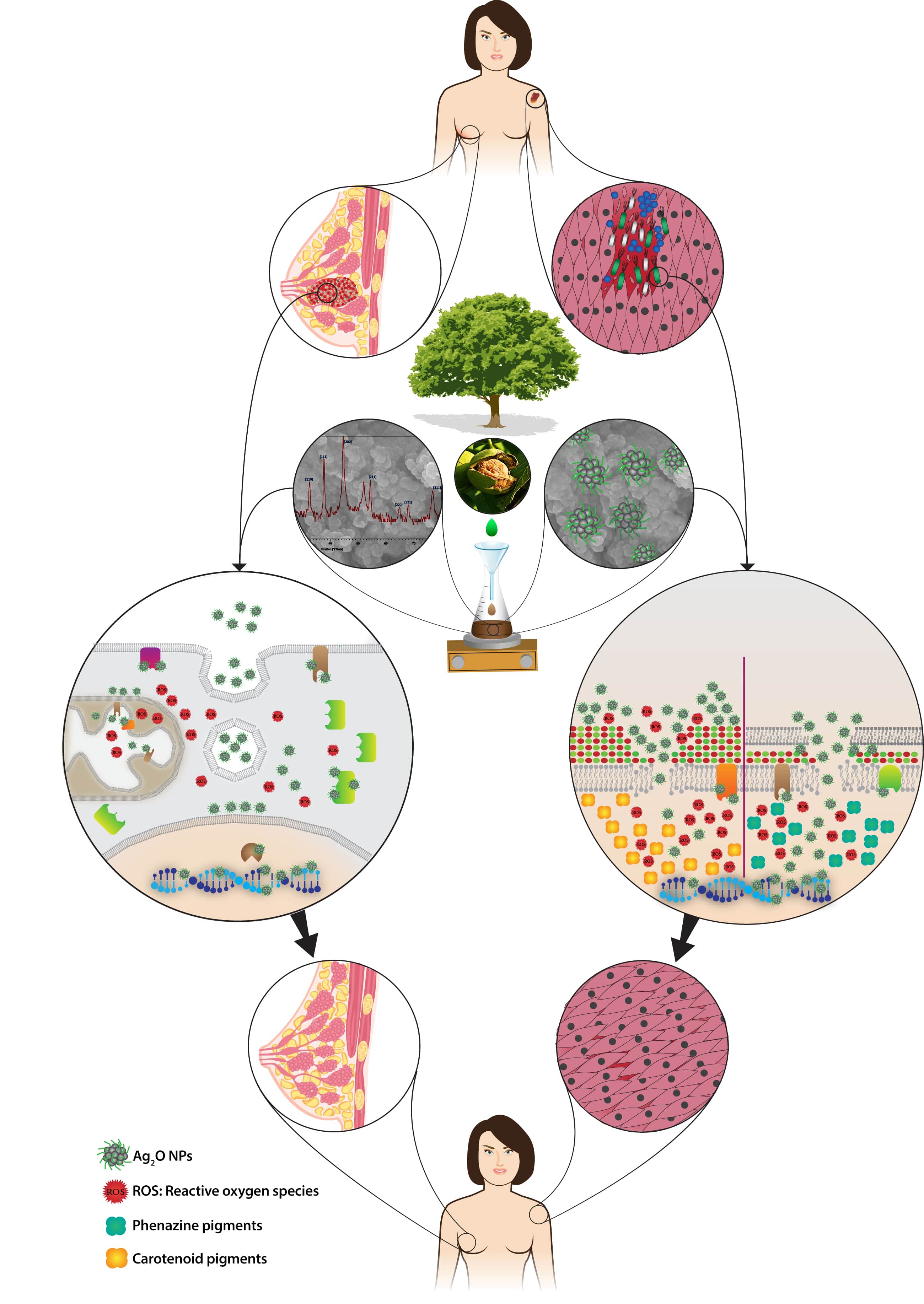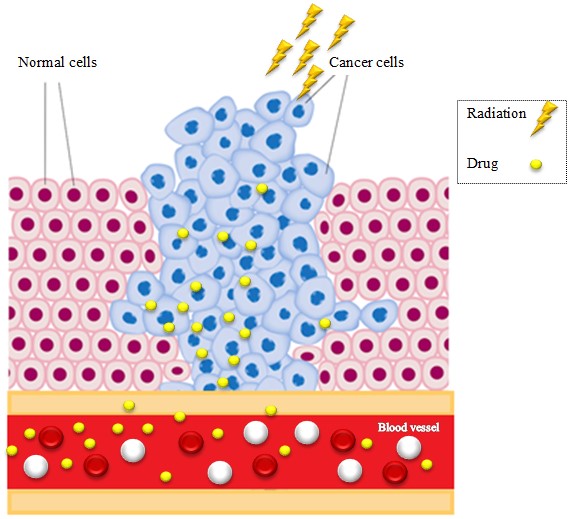1 Drug delivery systems
1.1 Cyclodextrin based nanocarriers
1.3 Graphene oxide based nanocarriers
1.4 Biological nanocarriers (milk protein)
1.5 Responsive polymeric nanocarriers
1.6 Carbon nanotube (CNT) nanocarriers
2 Nanotheranostics
2.1 Nanotheranostics in cancer therapy
3 Biosensors
3.1 Cyclodextrin based biosensor
4 Biomaterials
4.1 Wound dressing
5 Green Synthesis of Nanostructures
6 Medical Imaging
6.1 CT/MRI
7 DNA Nanostructures
7.1 DNA Origami
8 Multimodal Therapy
8.1 Combination of chemotherapy and radiotherapy
1.1 Cyclodextrin based nanocarriers
Cyclodextrins are cyclic oligosaccharides made from different numbers of glucopyranose that are conjugated to each other through α-1,4 glycosidic bonds. They are considered as a class of host-guest nano-complex which are used in different shapes (rotaxane, pseudorotaxane, nanocapsule, nanosponge, …) for delivery of hydrophobic components such as hydrophobic drugs. The aim of these complexes is to bring an enhancement in the solubility and bioavailability of hydrophobic drugs like different types of anticancer drugs.

Figure1. Schematic of different types of supramolecular cyclodextrin nanocarriers.
1.2 SPION based nanocarriers
Superparamagnetic iron oxide nanoparticles are considered as contrast agents for use in magnetic resonance imaging (MRI) which can be good alternatives for toxic gadolinium particles. Coating the surface of these particles with biocompatible polymers not only improves their colloidal stability and biocompatibility but also provides the ability of drug/gene loading by the nanocarriers. Based on these excellent properties these nanoparticles can be applied as theranostic agents in the field of nanomedicine.

Figure2. SPION applications: therapy and diagnosis.
1.3 Graphene oxide based nanocarriers
Graphene oxide is a class of graphene based nanosheets that is composed of some graphene sheets which are oxidized under certain conditions. The presence of carboxyl groups (as hydrophilic groups) at the corner of the sheets and the hydrophobic surface of the sheets introduced them as a carrier for both hydrophobic and hydrophilic drugs. Moreover, they can be modified with different polymeric shells in order to increase their water solubility, biocompatibility and drug loading capacity.

Figure3. Graphene oxide as a drug delivery system.
1.4 Biological nanocarriers (milk protein)
Biological agents such as some milk proteins can act as favorite nanocarriers for hydrophobic drugs. In these cases, biological agents can be formed in different shapes like micelles, liposomes, and so on due to their three-dimensional structural and molecular features and drugs can be inserted in the hydrophobic part of nanocarrier.

Figure4. Milk proteins can act as nanocarrier for drug delivery.
1.5 Responsive polymeric nanocarriers
Responsive polymers or smart polymers are a new class of polymers that can act as coating agents for nanoparticles or as nanocarriers themselves. The performance of these polymers is based on their capability of responding to very small changes in the environment such as pH, temperature, redox, light and etc.

Figure5. Stimulating factors for responsive polymers.
1.6 Carbon nanotube nanocarriers
Carbon nanotubes (CNT) have appeared to be encouraging candidates for anti-cancer drug delivery systems, since they provide potential advantages such as a higher surface area (1300 m2/gr) allowing higher drug loading and the possibility for accompanying additional therapeutic ligands through surface functionalization. In addition, their inherent stability and architectural flexibility lead to prolonged circulation time; and consequently improving the bioavailability of the drug molecule.

Figure6. CNTs as nanocarriers for drug delivery.
1.7 Liposomal nanocarriers
Liposomes can serve as promising carriers for targeted delivery and controlled release of anti-cancer drugs. They have the most similar structure to the cell membrane which consists of the amphiphilic lipid bilayer(s) with a hydrophilic head and a hydrophobic tail. Drugs can be trapped either in the internal polar cavity or within the nonpolar layer.

Figure7. Liposomal drug delivery system
2.1 Nanotheranostics in cancer therapy
Theranostics is “The fusion of therapeutic and diagnostic technologies” to monitor early response to treatment and predict treatment efficacy. It could optimize the efficacy and safety of therapeutic regimes by monitoring the response to treatment as well as performing noninvasive imaging instead of repetitive biopsies with severe trauma. Cancer nanotheranostics is the science and technology of fabricating nanoplatforms to co-deliver both imaging and therapeutic components to cancer sites. The advantages of Nanotheranostics over conventional Theranostics come out from the significant properties of materials when turning into nano-size such as increasing the payload per surface, precluding from being readily cleared through the kidneys, extending circulation in the blood pool, and easily extravasating from the blood pool into tumor tissues and be retained due to poor lymphatic drainage (EPR).

Figure8. Schematic of a theranostic nanoparticle
3.1 Cyclodextrin based biosensor
Cyclodextrin encapsulation ability can be applied for the synthesis of different types of biosensors. These nanosystems can be synthesized through a combination of cyclodextrin with other nanomaterials or by using cyclodextrin alone. These new types of biosensors are useful materials for determining the number of different types of pollutants, drugs, hormones, and heavy metal ions.

Figure9. Schematic of a nanocomposite of cyclodextrin and conductive substrate for biosensing applications
3.2 Aptamers based biosensor
Aptamers biosensors are very specific sensors consist of single-stranded nucleic acids (DNA or RNA) that are selectively bound to the target molecule. This aptamers technology is a biomedical diagnosis approach that can be used to identify different types of desired molecules at the same time, the advanced technology which is named as lab on a chip.

Figure10. Aptamers biosensor.
3.3 Graphene based biosensor
Graphene and its derivatives with unique properties like high specific surface, good mechanical flexibility, and high thermal and electrical conductivity are candidates for the synthesis of different types of biosensors. Here they can act as substrates for attachment of other component like aptamers, enzymes, ligands, nanoparticles and so on.

Figure11. Schematic of graphene based biosensor.
4.1 Wound dressing
Covering the wound by bands is a helpful method for its healing. In this context, the nanocomposite of polymers and anti-bacterial nanoparticles can be ideal candidates for use in wound dressing applications. These nanocomposites not only prevent the bacterial contaminations but also by loading different components in the composite can accelerate the healing process.

Figure12. Wound dressing nanocomposite.
5.1 Green synthesis of silver nanoparticles
Green synthesis is a new and safe method for the synthesis of different types of nanoparticles without using chemical solvents. In this approach, nanoparticles are synthesized by reduction of a certain metal salt to its zero charge model in the presence of the extract of plants or animals or through the extraction of the as-prepared nanoparticles which are inside the body of bacteria. Among them, silver nanoparticles are the most famous nanoparticles which are synthesized by this approach in recent years due to their wide applications as anti-microbial agents.

Figure13. Green synthesis of nanoparticles.
6.1 CT/MRI
Combining different types of diagnostic approaches is a useful method for enhancing the detection process since each one has advantages and disadvantages and can cover the defects of each other. In fact, by using multimodal imaging agents in a single nanocarrier and comparing the resulted images, detection of the disease and its recovery process can be improved. As an example, it can be noted to the iron oxide – Au core-shell nanoparticles which can be used in the combination of the CT/MR imaging approach.

Figure14. CT/MR imaging by Fe3O4-Au core-shell nanoparticles.
7.1 DNA origami
DNA origami is a subclass of nanobiotechnology which is based on the modeling of long single-stranded DNAs into the desired shape through an intermolecular junction between complementary base pairs. Biocompatibility, availability, and ease of production introduce these nanosystems as ideal candidates for different applications like drug/gene delivery.

Figure15. Synthesis of different nanostructures with DNA.
8.1 Combination of chemotherapy and radiotherapy
Multimodal therapy is the simultaneous use of two or more therapeutic approaches in order to improve their therapeutic effects. In this context, it can be noted to the combination of chemotherapy and radiotherapy in which chemotherapeutic approach is used to stop the cell cycle of diseased cells in a stage that is sensitive to the radiation and so can enhance its curative efficacy.

Figure16. Combination of chemotherapy and radiotherapy for cancer cell therapy.